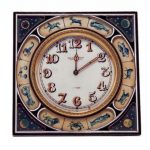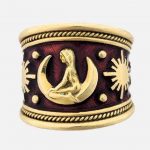Vitreous enamel, also called porcelain enamel, is a material made by fusing powdered glass to a substrate by firing, usually between 750 and 850 °C (1,380 and 1,560 °F). The powder melts, flows, and then hardens to a smooth, durable vitreous coating. The word comes from the Latin vitreum, meaning “glassy”.
Enamel can be used on metal, glass, ceramics, stone, or any material that will withstand the fusing temperature. In technical terms fired enamelware is an integrated layered composite of glass and another material (or more glass). The term “enamel” is most often restricted to work on metal, which is the subject of this article. Enamelled glass is also called “painted”, and overglaze decoration to pottery is often called enamelling. Reference: Enamel
The British Worthies: an important London enamel plaque by William Hopkins Of oval form sumptuously painted with a column surmounted with four plaques of British Worthies inscribed with names and dates, ‘Earl Howe June 1st 1794’, ‘Earl St Vincent Feby 14th 1797’, ‘Viscount Duncan Octr 11th 1797’, and ‘Baron Nelson Augt 1st 1798′, framed by interlocking laurel wreaths, at its base instruments of sea navigation, including a telescope, astrological globe, compass, backstaff and anchor, to the left side sits Britannia resting her right arm on her flagged shield, pointing with her left arm to the names of the Worthies, on the other side a Lion tramples over the flags of France, Spain and the Netherlands, in the background a man o’ war flies the colours of Britain, signed on the corner of the footed platform ‘W.H.Craft: Invt et fect 1798’, in a most elaborate carved giltwood frame with all manner of naval trophies and surmounted by a shell and emblems of Peace and Plenty, the plaque 28.7cm x 33cm, the frame 60cm wide overall
Sold for £ 11,250 inc. premium at Bonhams in 2011
Striking table clock with alarm; gilt-metal; square; pilaster at each corner inlaid with embossed silver plates; plinth and frieze inlaid with silver band embossed with palmettes; dome top pierced and surmounted by lion; door on each side, set with modern niello medallion, two with busts of Doges of Venice (Leonardus Loredanus and Augustinus Barbarigus), third with Lion of St Mark; dial shows hours I-XXIIII, day of month and phases of the moon; month circle with signs of the Zodiac in relief and gilt on ground of blue enamel.
The dial comprises a disc assembly with epicyclic gearing driving moving bands. The assembly rotates within a silver hour chapter ring that is fixed to the front panel of the clock. The following describes the bands from the outside in;1) Silver chapter ring (fixed); 1.1) Hours. The hours “I” to “XXIIII” are engraved and filled with black wax. The hour “XVIII” is at the top of the chapter ring, indicating the start to the day is at 18:00 [suggesting the use of the Italian/Bohemian hour system]. The hour is indicated by the largest flare of the sun effigy, which is born on the dial assembly and rotates once in 24 hours. 2) Silver outer band of dial assembly (driven by epicyclic gearing that is born within the assembly); 2.1) Annual calendar. The months are provided in abbreviated English; “DECE”, “NOVE”, “OCTO”, “SEPT”, “AVG”, “IVLI”, “IVNI”, “MAI”, “APRI”, “MAR”, “FEBR” and “IANV”, engraved and filled with black wax. Each month has six subdivisions, i.e. approx. 5 days. The approximate date is indicated by the largest flare of the sun effigy. 2.2) 12 signs of the zodiac, raised and gilded on a blue enamel ground. The position of the Sun in the zodiac is indicated by largest flare the sun effigy.3) Gilt brass sun ring (revolves once in 24 hours with main dial assembly). 3.1) Sun effigy. The largest flare is the “hand” of the clock. 3.2) Glyphs for the major astrological aspects; asterisk [sextile], square [square], triangle [trine] and linked circles [opposition].4) Silver inner disc (driven by epicyclic gearing that is born within the dial assembly) 4.1) Age of the moon (days). The days (1-29.5) are engraved and in-filled with black wax. 4.2) Phase of the moon (pictorial). The phase of the moon is indicated in the aperture of the disc. The disc is engraved to suggest stars in the night sky. Behind the disc, the moon phase curve is engraved on a silver plate, with a ground of blue enamel which is damaged and missing in parts.
Reference: © The Trustees of the British Museum
A VIENNESE SILVER-GILT, ENAMEL AND ETCHED ROCK-CRYSTAL OVAL BOX CIRCA 1880 With astrologically decorated panels with etched glass titles, on four sphinx feet 4 ¼ in. (10.8 cm.) high, 9 ¼ in. (23.5 cm.) wide, 8 ¼ in. (21 cm.) deep
Sold for USD 17,500 at Christies in 2017
French Enameled Silver Astrological Desk Clock Retailed by Mappin & Webb Of square form, in black and white, the circular dial with Arabic numerals, decorated with the twelve signs of the zodiac. Height 4 5/8 inches, width 4 1/2 inches.
Sold for $1,500 (includes buyer’s premium) at Doyle New York in 2009
An 18 karat yellow gold and red enamel Virgo ring, from the Zodiac collection. Elizabeth Gage. The tapered red enamel band set with polished gold astrological symbols. Stamped Gage, with English assay mark and maker’s mark. Size 6 1/2. Gross weight is approximately 12.8 grams.
Sold for $1,500 at AVCTION in 2019
Nine-Gem (Navaratna) Talismanic Bracelet, One of a Pair Object Name:Bracelet Date:19th century Geography:Made in Northern India Medium:Gold, enamel; inset with turquoise, chrysoberyl, sapphire, topaz, hyacinth, ruby, emerald, diamond, coral, pearl
Talismanic and astrological attributions of gems and stones have a deep history in the Indian subcontinent. In the navaratna (nine gems) series, specific precious gems each relate to one of the nine planets of the astrological system. This bracelet is composed of ten gems in a variation of the traditional grouping, and the back of each setting is enameled with a four-petalled blossom in green.
Reference: The Metropolitan Museum of Art
Table clock German (Augsburg) about 1625–50
Astronomical quarter striking astrolabic and zodiacal table clock. Gilt with astronomical & astrological dials on four sides, of silver with blue, orange & green enamel. Two bells in top. Frame engraved with scrolls & fruit, medallions on two sides of base; vases on two ends under dials, and landscapes on front and back. Musical mechanism added above gallery on top. This elaborate clock in the form of a building is as much a precious work of art as a complicated scientific instrument. Dials on this side record the time of day and night, days of the week, months, seasons, signs of the zodiac, and the date according to an ancient Roman calendar. The other side measures astronomical time and the position of the sun and moon at various times of day. Additional dials allow one to set an alarm and regulate the striking of hours and quarter hours. Such complex mechanisms were awe-inspiring wonders of their day. The ability to measure the known universe with man-made machines was a potent demonstration of its owner’s knowledge, power, and wealth.
Reference: Museum of Fine Arts Boston
J. N. ADORNO A GEOGRAPHICAL AND ASTRONOMICAL WATCH NO. 1 MADE BY THE INVENTOR A UNIQUE GOLD AND ENAMEL ASTRONOMICAL DOUBLE DIAL MINUTE REPEATING INDEPENDENT SECONDS WATCH WITH CALENDAR AND MOON PHASES CIRCA 1875 The Movement: • 17 lignes gilt two train movement, lever escapement, bi-metallic compensation balance, movement signed J.N. Adorno Mexico & London, stem wind with pin setting for time, slide repeat The Dials: • the front: dial with a detailed revolving map of the Southern Hemisphere seen from the South Pole and painted in turquoise and tones of beige, with blued steel chapter ring, calibrated for 24-hours and divided 1-12 twice, numerals engraved on polished steel stars with a window at 12 o’clock to show month, day and date on three concentric silver chapter rings, further with independent center seconds hand beating one second intervals, with lock on band, the crystal with a semi-circular shaded area to indicate night time hours • the reverse: dial with similar revolving map of the northern hemisphere seen from the North Pole, both maps signed J.N. Adorno’s patent, surrounded by two blued steel revolving rings marked with principal stars and geared to a revolving moon half polished and half blued steel to indicate the phases of the moon, the calendar work and moon phases manually advanced by a single slide The Case: • the case chased with interlaced ribbonwork, enameled with two laurel sprays with translucent green leaves tied by red enamel bows and also signed in champlevé white enamel J.N. Adorno’s Geographical and Astronomical Watch No.,1 Made by the Inventor, with unusual crown set up composed of a sphere rotating within a fluted gold bow with hinged suspension loop, the band fitted with similarly chased slide for the repeat, start /stop button for the independent seconds and calendar setting slide
Sold for 68,750 USD at Sothebys in 2013










